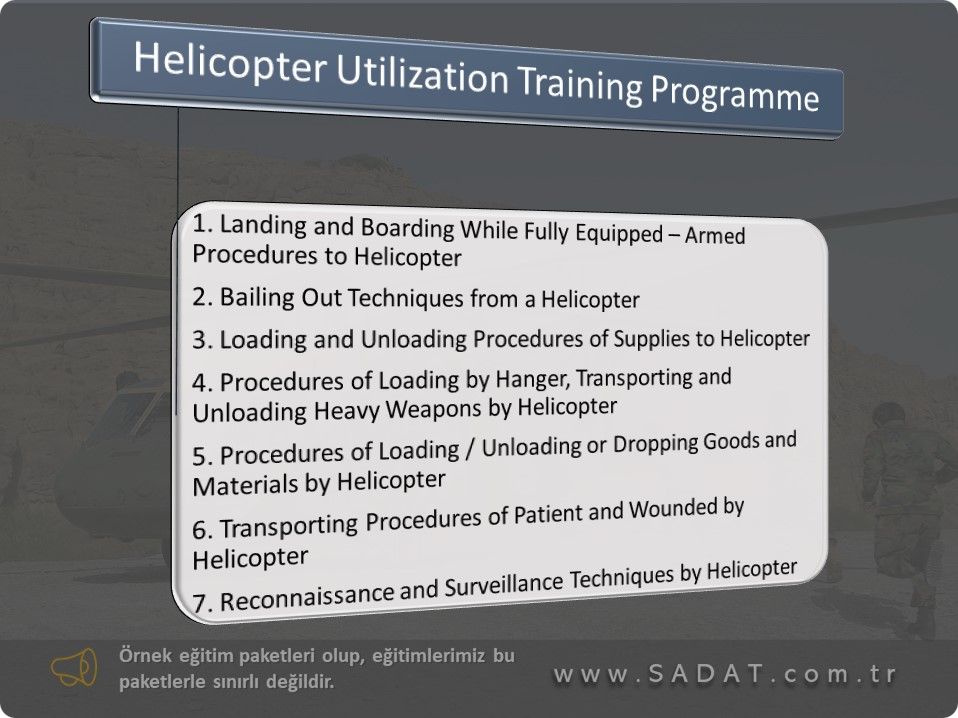Helicopter Utilization Training Programme
General
Helicopters can take off and land vertically and can stay in the air (by “Hovering”). When the main shaft axis (rotation plane) of the propeller is tilted, that is, the direction of the lift force created by the propeller is changed, the helicopter moves BACK and FORTH – RIGHT and LEFT. Thus, the helicopter moves in the air. Since the propeller is constantly rotating (due to the moment it creates on the fuselage), it also tries to rotate the helicopter’s fuselage. To prevent this, a smaller propeller is used at the tail of the helicopter. The propeller in the tail absorbs the moment of rotation (torque) on the fuselage. In addition, the rotation of fuselage can be achieved by changing the amount of damping. Military Helicopters are manufactured for various purposes such as;
- Attack Helicopters,
- Reconnaissance & Surveillance Helicopters,
- General Purpose Helicopters,
- Ambulance Helicopters
Purpose of Training
By learning the technical features of the helicopter and the use of the weapons and technical equipment on it, both the crew and the transported personnel, at the highest level theoretically and practically;
Transportation Reconnaissance, Surveillance and Close Air Support missions to provide maximum benefit from the helicopter on the battlefield.

Training Subjects[1]
- Landing and Boarding While Fully Equipped – Armed Procedures to Helicopter
- Bailing Out Techniques from a Helicopter
- Loading and Unloading Procedures of Supplies to Helicopter
- Procedures of Loading by Hanger, Transporting and Unloading Heavy Weapons by Helicopter
- Procedures of Loading / Unloading or Dropping Goods and Materials by Helicopter
- Transporting Procedures of Patient and Wounded by Helicopter
- Reconnaissance and Surveillance Techniques by Helicopter
Types of Helicopter Operations
- Air-Mobile Operations
In cases where the transfer of Special Forces Teams, Underwater Offense Teams, Infantry Commandos and Gendarmerie Commandos, Infantry / Marine Infantry and Gendarmerie Units over the ground is not deemed appropriate or it is deemed necessary to move quickly; It is the operation of transporting by aircrafts from one place to another by landing and transporting a large number of helicopters.

- Landing and Boarding Tasks from/to Helicopter to Ground with “Fast Rope”
It is the process of landing on a steep and rocky summit, behind enemy lines, behind a natural cover, on the roof of a building, on the deck of a ship, etc.

- Airborne Operation
It is the transfer of Special Force, SAT (Underwater Offense)/SAS (Underwater Defense) or Commando teams equipped with parachutes to the operation area by helicopter from the air. It is the process of transporting the troops by helicopter to the operational area but parachuting into the ground in teams.

- Close Air Support Operation
It is the task of supporting the operation of the ground troops by fire.

- Reconnaissance and Surveillance Operations
It contributes to meet the needs of long-range reconnaissance and surveillance in order to supplement the limited intelligence information of the ground troops regarding the enemy’s position and movements in the depths of the front.

- Supply and Transport – Medical Evacuation Tasks:
The needs of the front line or reserve units in contact with the enemy can be fulfilled for the purpose of supplying emergency food, ammunition, CBRN, etc., for the transportation of light or heavy weapons, and even for the transportation of the seriously wounded ones.

Initial Requirements
- Helicopter Pilots:
- They must have successfully completed basic military service and Individual Combat Training and combat shooting with their own weapons.
- They must have successfully completed Helicopter Pilot Basic and Advanced Flight Courses and Night Flights.
- Personnel to be Transported:
- Teams / Units to be transported by helicopter must have successfully completed the Basic Military Service, Individual Combat training required by their class and branch, and combat shooting with their own weapons.
- Combat Teams / Units to be transferred must have successfully completed the troop training and exercises required by their class and branch, the crew training of the weapons to be used by the crew, and the Combat shooting.
-
The Supply and Logistics Unit Personnel must have reached professional standards in order to successfully perform the tasks required for their duties as staff member in all weather and difficult conditions.
Abilities to be Gained After the Training
- Being trained in the use of helicopter-mounted heavy weapons, firing at airborne targets and ground troops.
- Having successfully completed the training of landing and take-off techniques on a faulty and steep terrain or a ship in emergency or dangerous conditions.
- Having successfully completed Aerial Reconnaissance and Surveillance Techniques and reporting procedures training.
- Having successfully completed the training of helicopter intercommunication system, radio communications with superior, subordinate and neighboring units.
- Having successfully completed the training on loading and unloading procedures for personnel and cargo transportation by helicopter.
- Having successfully completed the training of patient and wounded transport and evacuation procedures by helicopter.
- Gaining experience by successfully completing joint operations training and shooting drills for the combat teams / units to be transferred.
- Supply and Logistics Unit Personnel:
Being trained and experienced in the methods of loading and unloading the Weapons and Vehicles to be transported on the helicopter. - Medical Evacuation Teams:
Gaining knowledge, ability and experience in evacuating the seriously injured units on the battlefield to the Mobile Surgical Hospitals behind the front or to the fully equipped hospitals in the Domestic Region.
DURATION OF COURSE
The theoretical training is 1 week, the practical training is 2 weeks, for a total of 3 weeks.
[1] These subjects are common training subjects that should be implemented in all Helicopter Squadrons of Air Forces Helicopter Squadrons, Land Forces Aviation Units, Gendarmerie General Command and Naval Forces Aviation Units, regardless of difference in any force of any country. Depending on the nature of the force, some trainings may be more important than others..


